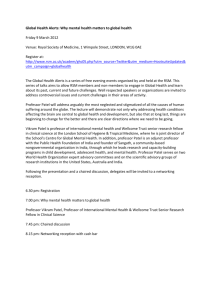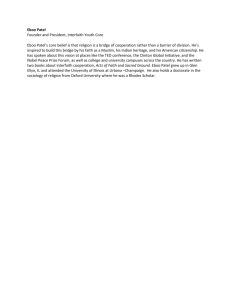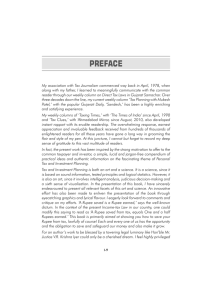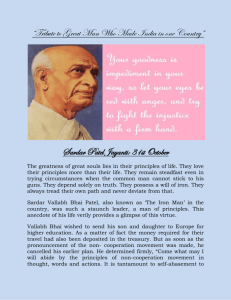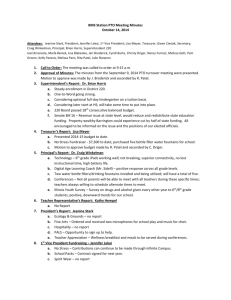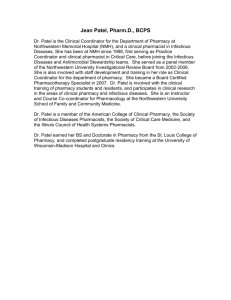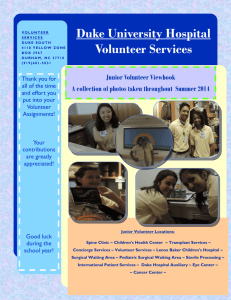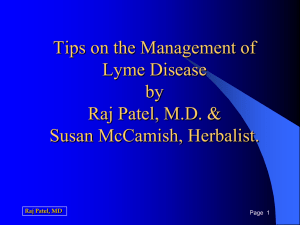stuffed and starved - University of San Diego
advertisement
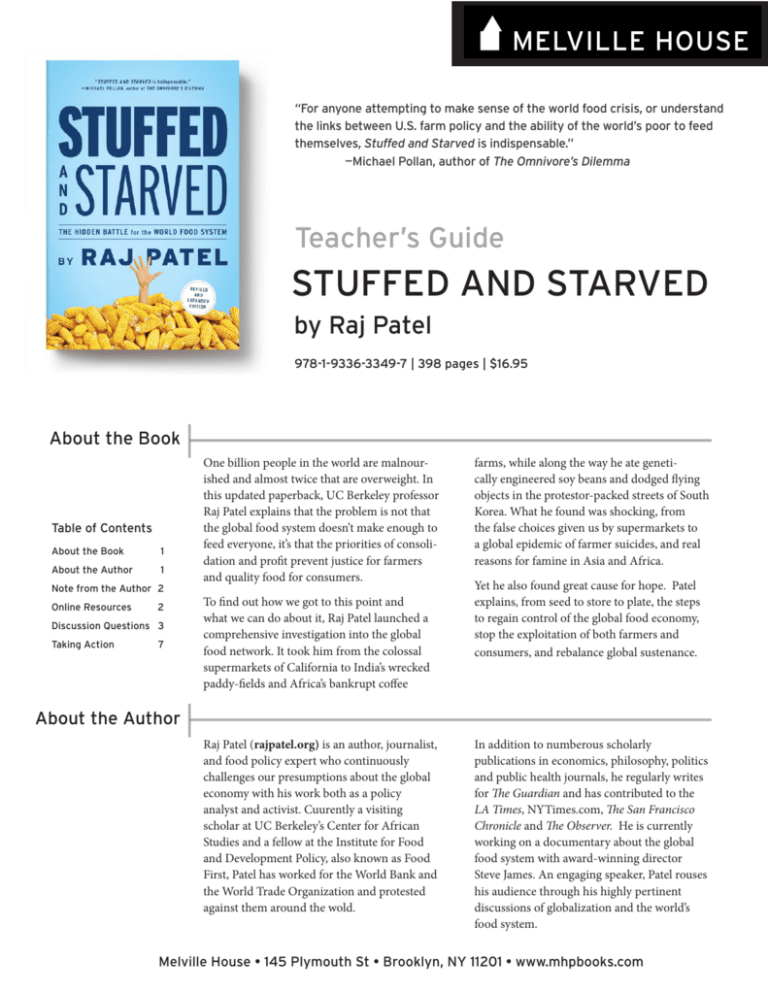
“For anyone attempting to make sense of the world food crisis, or understand the links between U.S. farm policy and the ability of the world’s poor to feed themselves, Stuffed and Starved is indispensable.” —Michael Pollan, author of The Omnivore’s Dilemma Teacher’s Guide STUFFED AND STARVED by Raj Patel 978-1-9336-3349-7 | 398 pages | $16.95 About the Book Table of Contents About the Book 1 About the Author 1 Note from the Author 2 Online Resources 2 Discussion Questions 3 Taking Action 7 One billion people in the world are malnourished and almost twice that are overweight. In this updated paperback, UC Berkeley professor Raj Patel explains that the problem is not that the global food system doesn’t make enough to feed everyone, it’s that the priorities of consolidation and profit prevent justice for farmers and quality food for consumers. To find out how we got to this point and what we can do about it, Raj Patel launched a comprehensive investigation into the global food network. It took him from the colossal supermarkets of California to India’s wrecked paddy-fields and Africa’s bankrupt coffee farms, while along the way he ate genetically engineered soy beans and dodged flying objects in the protestor-packed streets of South Korea. What he found was shocking, from the false choices given us by supermarkets to a global epidemic of farmer suicides, and real reasons for famine in Asia and Africa. Yet he also found great cause for hope. Patel explains, from seed to store to plate, the steps to regain control of the global food economy, stop the exploitation of both farmers and consumers, and rebalance global sustenance. About the Author Raj Patel (rajpatel.org) is an author, journalist, and food policy expert who continuously challenges our presumptions about the global economy with his work both as a policy analyst and activist. Cuurently a visiting scholar at UC Berkeley’s Center for African Studies and a fellow at the Institute for Food and Development Policy, also known as Food First, Patel has worked for the World Bank and the World Trade Organization and protested against them around the wold. In addition to numberous scholarly publications in economics, philosophy, politics and public health journals, he regularly writes for The Guardian and has contributed to the LA Times, NYTimes.com, The San Francisco Chronicle and The Observer. He is currently working on a documentary about the global food system with award-winning director Steve James. An engaging speaker, Patel rouses his audience through his highly pertinent discussions of globalization and the world’s food system. Melville House • 145 Plymouth St • Brooklyn, NY 11201 • www.mhpbooks.com A Note From the Author “When I was in school, my friends and I were fired-up by the big questions—questions of inequity, questions of basic fairness. Why do some people have so much, while others have so little? Why do some people go hungry, while others are obese? Is there really not enough food to feed the world? We can take real, profound steps to regain control over the global food system. We can go beyond small acts of ethical consumerism. Together, we can create a more democratic, sustainable and joyful food system.” —Raj Patel Trying to answer those questions has been driving my research, and my life, ever since. And finding real workable solutions seems more crucial now than ever. Globally, nearly a billion people are going hungry, while two billion are overweight. Food—its availability, cost, quality and quantity—is one of the biggest issues we face today. And though the stories and the statistics may be bleak, as I researched further I also found great cause for hope. People are working to create a more equitable food economy. There are things to be done, and people are doing them. Critical Reception “One of the most dazzling books I have read in a very long time. The product of a brilliant mind, and a gift to a world hungering for justice.” — Naomi Klein, author of No Logo and The Shock Doctrine “Compelling. At first glance, Raj is another depressing voice in the chorus. But in traveling the world researching the book, he also found hope in international social movements working to create more democratic, sustainable, and joyful food systems.” —Mark Bittman, New York Times “Stuffed and Starved remains a brilliant didactic account of the powerful interests (dis) organizing our food systems, and why, when food is an object of profit, there are no modern solutions to modern problems such as endemic hunger, ill-health and environmental degradation…Raj Patel’s unique sensibility and intelligence in evaluating grassroots alternatives provide a road map to understanding and changing the world through re-centering 2 food as a cultural anchor rather than a product, especially at this moment of environmental uncertainty.” —Philip David McMichael, author of Development and Social Change “A book full of insight, that makes an important contribution to understanding that the politics of food is not a narrow matter of shopping, ethical or otherwise.” —Guardian “Patel’s broad treatment helps the layman connect the dots, as well as hear the voices of those who occupy the lower rungs of the global food chain.” —Time Magazine “A blistering indictment of the policies of multinational agribusiness conglomerates and charges that their drive for profit at any cost has left the developing world starving while wealthy countries like the United States are experiencing epidemic obesity rates and related health problems.” —Newsweek www.mhpbooks.com Guided Reading & Discussion Questions Chapter 1: Introduction 1. Explain why the apparent choices that supermarkets present us with—whether it be varieties of apples, brands of cereal, or kinds of coffee—are not really our own. If the food we find there is not dictated by the consumer, the seasons, our locations or by the full range of foods, fruits, and vegetables available, explain how corporations the ones to be in control? (page 10) 2. When children grow up malnourished, they have a greater risk of obesity when they become adults because their bodies metabolize and store food poorly. Can you suggest some solutions for this problem? (page 12) 3. Why is it significant that we don’t know anything about the farmers who grow the crops for the foods we find at our supermarkets? What are some questions we could be asking if we want to be informed consumers? (page 16) 4. Explain how the laws of supply and demand work for coffee growers like Lawrence Seguya, a coffee-grower in Uganda. (page 17) 5. What does it mean when author Raj Patel says that “there’s a bottleneck in the [global food] distribution chain.” Examine the charts on page 21 (see below). Who is at the top? Who is at the bottom? How does the system work in terms of the concentration of power for the players involved? 6. What are some of the ways that farmers and consumers are fighting back? (page 23) United States People employed in agriculture and migrant and seasonal labor: 4,711,509 Farm operators: 3,337,450 Number of farms: 2,204,792 Farm product raw wholesalers: 6,628 Food manufacturers: 27,915 Grocery and related products wholesalers: 33,794 Food and beverage stores: 146,084 Consumers: 302,200,000 European Union People working in agriculture: 26,669,000 Farm holdings: 13,700,400 Number of farm holders: 50,400 Agricultural wholesale enterprises: 46,300 Food and beverage manufacturers: 308,300 Wholesaling food and beverage enterprises: 210,300 Food and beverage retail locations: 914,500 Consumers: 499,800,000 Figure 1.1 Hourglasses: the concentration of power and players in the food system. (Source for ‘United States’: Passel, 2009; Population Reference Bureau, 2007; US Census Bureau, 2007; USDA, 2007. Source for ‘European Union’: EU, 2010; Eurostat, 2009; Marcu, 2009) 3 Guided Reading & Discussion Questions Chapter 2: A Rural Autopsy 1. Why are farmers in India, Sri Lanka, East Asia, Astralia, and other countries committing suicide? (page 29) 4. Who was Lee Kyung Hae and how was he involved with the Koren producer’s movement? (page 43) 2. How are these terrible tragedies of the working poor and the struggles of women being written out of the story of poverty? (page 38) 5. Why can’t farmers pay their debts? (page 47) 6. What are some of the ways that farmers and consumers are fighting back? (page 23) 3. According to Patel, what are some reasons why inequality might continue to be a major problem in India? (page41) Chapter 3: You Have Become Mexican 1) How has NAFTA effected Mexican farmers? (page 56) 4) Today Mexicans drink more Coca-Cola than milk. What are some other changes to the foods people eat as a result of NAFTA? (page 71) 2) What does Patel mean by “creative destruction” and how does this notion affect the poor? (page 60) 5) How did the United Farm Workers (UFW) movement in California organize grape growers in the 1960s? (page 77) 3) How has NAFTA and economic liberalization impacted migration? (page 69) 8 6 Farms (millions) 4 Acres per farm (hundred acres) 2 0 1850 60 70 80 90 1900 10 20 Land in farms (billion acres) 25 30 35 40 45 50 54 59 64 69 74 78 Fig. 2.1 Farm size and concentration in the United States 1850-2000 (Source: Hoppe and Wiebe 2003) 4 www.mhpbooks.com 82 87 92 97 Guided Reading & Discussion Questions Chapter 4: “Just a Cry for Bread” 1) Why was tea such a popular drink in England starting in the mid-1600s? 2) Where did the tea leaves come from and how did the global tea market work in terms of supply and demand? (page 88) 3) What is Rhodes’ Conundrum? (92) 4) How did the Marshall Plan influence the global food economy after WWII? What were the international and domestic worries about food surpluses in the US? (98) 5) Why was the inclusion of agriculture a key addition when the World Trade Organization was launched in 1995? (104) Chapter 5: The Customer Is Our Enemy: A Brief Introduction to Food System Business 1) You might think of the clothing store when you hear “Banana Republic,” but how does this term apply to countries in Central America and the Caribbean? (109) 3) Why was the discovery of high fructose corn syrup in the 1970s a breakthrough that would change the lives of millions? (123) 2) Explain how the concentration of market power in the food system (including seed supply companies and the packaged foods industry) has become a trend. (110) Chapter 6: Better Living through Chemistry 1) What was India’s “Green Revolution”? Would you say that it was successful or not? (page 134) 5) How can the pesticide industry be compared to the software industry? (page 144) 2) The Indian state of Kerala opted for a political solution. What did they do and why does Patel say that this approach to agrarian change “seems to have had a more enduring impact than the Green Revolution”? (page 137) 6) Describe some attempts to develop cros that will help the poor. (page 146) 3) How will a “second Green Revolution” in India be based not on fertilizers and improved seed but on biotechnology? (page 141) 7) What are some problems with geneically modified crops? (page 148) 8) How are agricultural biotechnology advances playing out in Africa and Cuba? (page 156) 4) What can engineered crops like Bt Cotton and the RoundUp-ready crops produced by the Monsonto Corporation promise to farmers? (page 143) 5 Guided Reading & Discussion Questions Chapter 7: Glycine Rex 1) What is lecithin, one of the “secret ingredients” you’ll find in a chocolate bar? (page 174) 2) Why did the popularity of soybeans reach a high point in the 1970s? (page 188) 3) Who is Blairo Maggi and what influence did he have on Brazil’s soy boom? (page 195) 5) What is the Landless Rural Workers Movement (“Movimento dos Trabalhadores Rurais Sem Terra” (MST) in Portugese) and why has Noam Chomsky called it “the world’s most important social movement”? (page 211) 4) What is the “sustainable soy” movement? (page 209) Chapter 8: Checking Out of Supermarkets 1) How did the “Self-Serving Store” patent influence the evolution of supermarkets in the US? (page 224) 2) How is the consumer controlled and tracked in a supermarket? (page 230) 4) How do systems like Community Supported Agriculture (CSAs) or coops like The People’s Grocery in Oakland offer effective alternatives to supermarkets? (page 254) 3) What are some surprising facts about Walmart in this chapter? (page 237) Chapter 9: Chosen by Bunnies 1) How does the history of the invention of food processing involve military conflicts? (page 261) 2) What is the Slow Food Movement? (290) What are the consequences of cooking less in the home and spending less time preparing food? (page 292) 4) What is “food sovereignty”? (page 297) 3) Analyze the chart on the next page. Conclusion: Inside the Hourglass In this final section, Raj Patel offers ten ways that we can, as individuals, can begin to change state of the world’s food system. See a summary in the “Taking Action” section to the right. 6 1) Which suggestions he gives do you think are most effective? 2) Which are most imporatant? 3) Are there any you disagree with? Explain your choices. www.mhpbooks.com Guided Reading & Discussion Questions 2.5 hours 1 hour 0.5 hour 15 min. 8 min. 1934 1954 1974 1994 2010 180 traditional cooking 150 minutes 120 90 modern appliances 60 prepared food 30 0 1920 1930 1940 1950 1960 1970 1980 fresh and home frozen foods delivery 1990 2000 2010 2020 Fig. 9.1 Home cooking times 1934–2010 (Source: Professor David Hughes, personal communication) Taking Action How can we make a difference? 1) Transform our tastes—don’t eat processed food, eat slowly, prepare your own food, and savour it. 2) Eat locally and seasonally. 3) Eat agroecologically—try to eat food grown in harmony with its local environment, learn about your local environment and grow your own food. 4) Support locally owned business. 5) All workers have the right to dignity —freedom to organize and work without persecution. 6) Profound and comprehensive rural change —build rural areas with economic opportunities and a quality of life that attracts families. 7) Living wages for all. 8) Support for a sustainable architecture of food—rethink open space and sprawl as we develop. 9) Snapping the food system’s bottleneck— among other things, end subsidies to agribusiness, aggressively police their monopolies and tax processed food to a level where it reflects the harm it does. 10) Owning and providing restitution for the injustices of the past and present—that rich countries of the Global North such as Britain forgive debts and pay reparations to countries exploited in the Global South. 7

